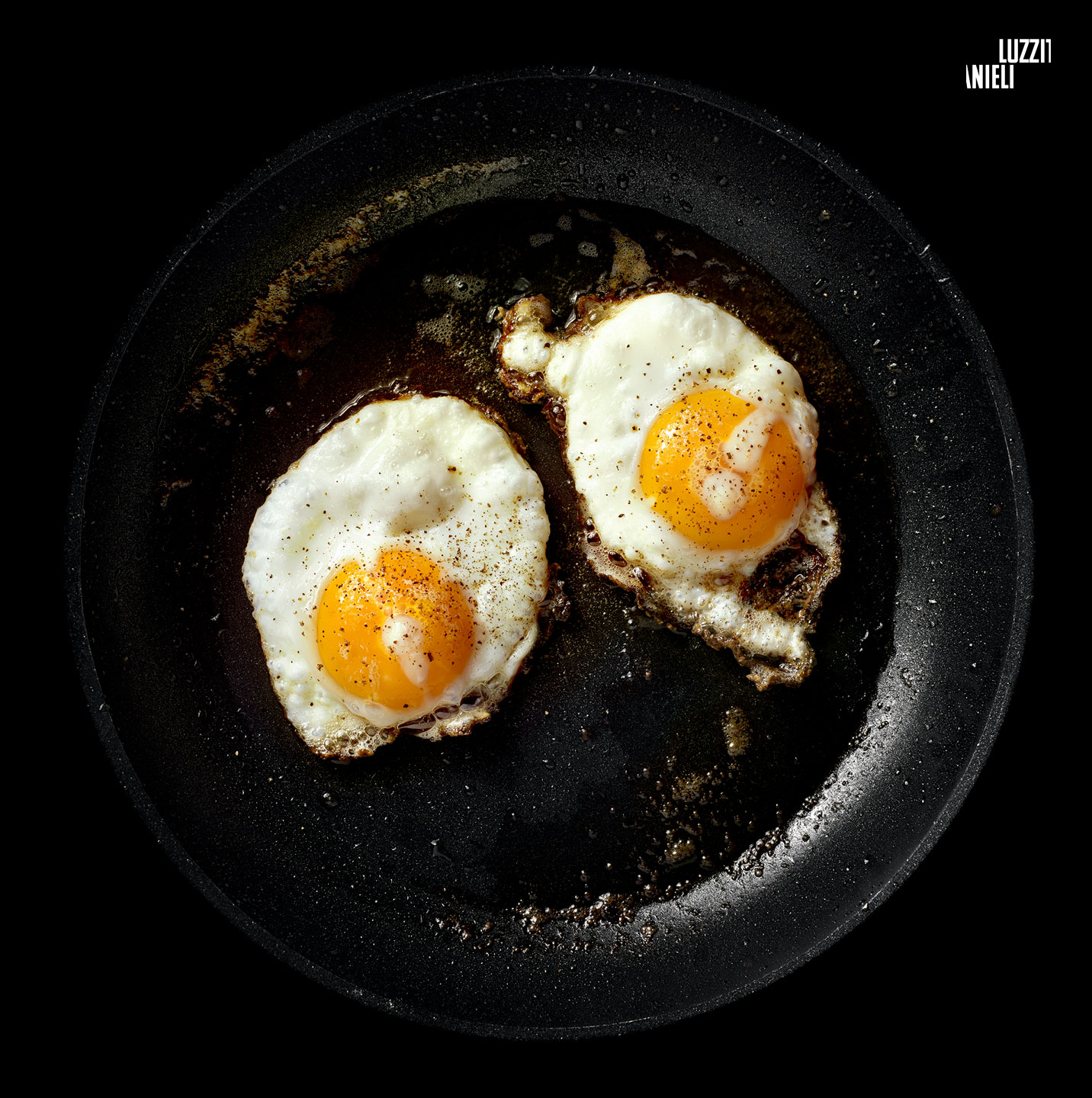Il fascino del cibo povero
Il Cibo ha sempre avuto un posto e un ruolo ben precisi nell’arte, in quella Classica e in quella Contemporanea, nelle scene religiose così come nelle nature morte, sullo sfondo oppure in primissimo piano, accessorio o al contrario protagonista. Nell’Arte Medievale e Moderna le vivande apparivano per ciò che erano, anche se talvolta potevano avere dei significati nascosti, misteriosi o al contrario facilmente riconoscibili; il Pane ad esempio rimandava all’Eucarestia, la Melagrana alla Fedeltà Coniugale, la Mela Morsicata alla Caducità della Vita…
Il primo a stravolgere il senso e l’uso comune dei generi alimentari è stato senza dubbio Arcimboldo che, già nel Cinquecento, si divertiva a realizzare curiosi Ritratti con Frutta e Verdura, creando un divertissement unico per la corte asburgica.
Tra tutti i movimenti artistici, la Pop Art è di certo quello che ha dedicato un posto di riguardo al Cibo; non esiste artista pop che non abbia realizzato almeno un’opera il cui protagonista sia un alimento. Andy Warhol ha creato una serie di litografie (Milano, Fondazione Mazzotta) che hanno per soggetto alcuni Dolci più o meno inventati, con fantasiose ricette per riprodurli, mentre Tom Wesselmannha inserito un po’ ovunque nei suoi quadri prodotti di grandi marchi americani, veri status symbol della società americana anni Sessanta (e non solo). E così in Still Life #30 (1963, New York, MoMA) fanno bella mostra di sé tutti gli alimenti che si possono trovare nella dispensa e nel frigorifero della famiglia perfetta della società consumistica (yogurt, frutta in scatola, cereali da colazione, pane da toast, pancakes…); alcuni oggetti sono dipinti, altri sono stati ritagliati dalla pubblicità e poi incollati sulla superficie pittorica, ma non fa differenza perché tutto è trattato nella stessa maniera, in modo Piatto e Artificioso, quasi banale, alla stregua di un advertising. Il vero Gastronomo della Pop Art rimane però Claes Oldenburg, con le sue Sculture Molli di vinile imbottito che riproducono cibi di largo consumo, come gelati, hamburger, patatine fritte e torte. Il suo cibo però non ha un aspetto gradevole e colorato, come le torte di Wayne Thiebaud ad esempio, ma mostra sempre un Lato Inquietante, che allontana qualsiasi desiderio di mangiarlo. È così in Floor Cake (1962, New York, MoMA), una gigantesca fetta di torta gettata sul pavimento, ma anche nel Dropped Cone di Colonia (2001), dove il cono gelato è conficcato nello spigolo di un palazzo, come se fosse appena caduto di mano ad un bambino mastodontico.
Nemmeno l’Arte Povera poteva tralasciare il cibo, nella sua continua ricerca di Materiali Fuori dalla Tradizione con cui creare opere d’arte inaspettate e ribaltare la presunzione di eternità che l’arte porta insita in sé sin dall’inizio. Cosa c’è di più deperibile di un Cespo di Insalata? Eppure Giovanni Anselmo (Senza titolo – Scultura che Mangia, 1968, Parigi, Centre Pompidou) ha pensato bene di inserirla tra due blocchi di granito (un materiale al contrario solidissimo e pressoché eterno), costringendo tutta la scultura alla precarietà e alla costante sostituzione di una sua parte fondamentale. Nello stesso periodo Piero Gilardi iniziò a realizzare i suoi Tappeti Natura, composizioni in poliuretano espanso che riproducono porzioni di Orto o Sottobosco, dove crescono frutti e ortaggi solo in apparenza genuini e succulenti che si rivelano poi essere di plastica e immangiabili. Un Ecologista Ante Litteram insomma, così come lo era Nino Migliori, con le sue fotografie di frutta e verdura intrappolate nel cellophane. Il belga Marcel Broodthaers invece ha usato il cibo, in particolare un Piatto Tipico Nazionale, per ironizzare e prendere in giro il proprio paese; le Cozze, vero simbolo del Belgio, emergono come una colonna compatta da una comunissima casseruola da cucina, in un accostamento dal sapore surrealista, così inaspettato eppure convincente
Se i lavori di Will Cotton rimandano a un Universo Iper-Zuccheroso, dai toni pastello e dalle atmosfere oniriche e fiabesche (Crown, 2012 oppure lo Chalet di biscotti, 2003), diverso è il significato che i Dolci, e in particolare le Caramelle, hanno nelle installazioni di Felix Gonzalez Torres. Le caramelle e i bastoncini di liquirizia infatti evocano lo Spettro della Morte e del Nulla che rimane dopo il loro consumo, ma sono anche una mera consolazione per coloro che rimangono
The charm of poor food
Food has always had a very specific place and role in art, in classical and contemporary art, in religious scenes as well as in still lifes, in the background or in the foreground, accessory or on the contrary protagonist. In Medieval and Modern Art, the food appeared for what it was, although sometimes it could have hidden, mysterious or on the contrary easily recognizable meanings; for example, the Bread referred to the Eucharist, the Pomegranate to Marital Fidelity, the Bitten Apple to the Caducity of Life …
The first to overturn the sense and common use of food was undoubtedly Arcimboldo who, already in the sixteenth century, enjoyed making curious Portraits with Fruits and Vegetables, creating a unique divertissement for the Habsburg court.
Among all the artistic movements, Pop Art is certainly the one that has dedicated a place of respect to Food; there is no pop artist who has not created at least one work whose protagonist is a food. Andy Warhol has created a series of lithographs (Milan, Mazzotta Foundation) which have as their subject some more or less invented sweets, with imaginative recipes to reproduce them, while Tom Wesselmann has inserted products of great American brands almost everywhere in his paintings, real status symbol of American society in the sixties (and beyond). And so in Still Life # 30 (1963, New York, MoMA) all the foods that can be found in the pantry and in the refrigerator of the perfect family of consumer society (yogurt, canned fruit, breakfast cereals, bread from toast, pancakes …); some objects are painted, others have been cut out of advertising and then pasted onto the pictorial surface, but it makes no difference because everything is treated in the same way, in a flat and artificial way, almost banal, like advertising. However, the true Gastronome of Pop Art remains Claes Oldenburg, with his Soft Sculptures of padded vinyl that reproduce widely consumed foods, such as ice cream, burgers, French fries and cakes. His food, however, does not have a pleasant and colorful appearance, like Wayne Thiebaud’s cakes for example, but it always shows a Disturbing Side, which removes any desire to eat it. This is the case in Floor Cake (1962, New York, MoMA), a gigantic piece of cake thrown on the floor, but also in Cologne’s Dropped Cone (2001), where the ice cream cone is stuck in the corner of a building, as if it were just fell from the hand of a mammoth child.
Not even Arte Povera could leave out food, in its continuous search for Materials Outside Tradition with which to create unexpected works of art and overturn the presumption of eternity that art carries within itself from the very beginning. What is more perishable than a Head of Salad? Yet Giovanni Anselmo (Untitled – Scultura che Mangia, 1968, Paris, Center Pompidou) has seen fit to insert it between two blocks of granite (a material on the contrary very solid and almost eternal), forcing the whole sculpture to precariousness and the constant replacement of a fundamental part of it. In the same period Piero Gilardi began to create his Natura Carpets, compositions in polyurethane foam that reproduce portions of the Garden or Undergrowth, where fruits and vegetables grow only in appearance genuine and succulent which then turn out to be plastic and inedible. In short, an Ecologist Ante Litteram, just like Nino Miglior was, with his photographs of fruit and vegetables trapped in cellophane. The Belgian Marcel Broodthaers, on the other hand, used food, in particular a Typical National Dish, to make fun of and make fun of his country; the Mussels, a true symbol of Belgium, emerge as a compact column from a very common kitchen casserole, in a combination with a surrealist flavor, so unexpected yet convincing
If Will Cotton’s works refer to a Hyper-Sugary Universe, with pastel tones and dreamlike and fairy-tale atmospheres (Crown, 2012 or the Chalet of biscuits, 2003), the meaning that the Sweets, and in particular the Candies, have in the installations of Felix Gonzalez Torres. In fact, candies and licorice sticks evoke the Ghost of Death and Nothingness that remains after their consumption, but they are also a mere consolation for those who remain


